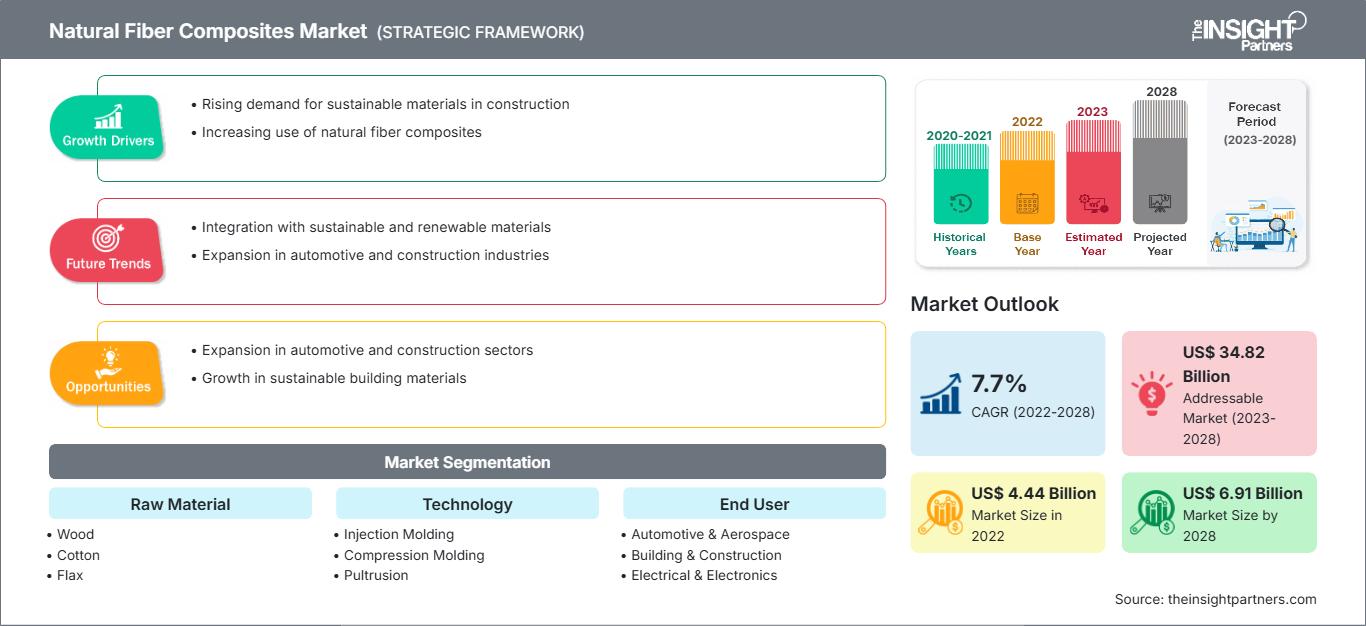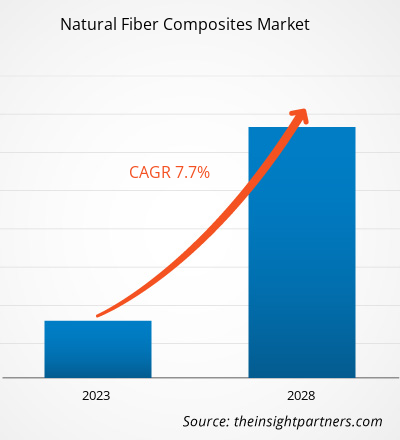Der Markt für Naturfaserverbundwerkstoffe soll von 4.438,83 Millionen US-Dollar im Jahr 2022 auf 6.910,46 Millionen US-Dollar im Jahr 2028 wachsen; von 2022 bis 2028 wird eine durchschnittliche jährliche Wachstumsrate (CAGR) von 7,7 % erwartet.
Naturfaserverbundwerkstoffe sind Verbundwerkstoffe mit einer Polymermatrix, in die hochfeste Naturfasern eingebettet sind. Naturfasern werden als Bestandteil von Verbundwerkstoffen verwendet, wobei die Faserausrichtung die Eigenschaften beeinflusst. In Verbundwerkstoffen beziehen sich Naturfasern häufig auf Pflanzenfasern, die aus lignozellulosehaltiger Biomasse gewonnen werden, wie Holzfasern und andere Pflanzenfasern aus Stängeln, Blättern, Früchten und Samen.
Die Nachfrage nach faserverstärkten (Glas- und Kohlenstofffasern) Verbundwerkstoffen ist relativ hoch. Sie sind jedoch teuer und nicht umweltfreundlich. Diese Fasern sind nicht erneuerbar und nicht recycelbar. Viele Länder der Europäischen Union und Asiens haben Vorschriften für die Automobilindustrie erlassen. Gemäß der Gesetzgebung der Europäischen Union aus dem Jahr 2006 sollten 80 % der Fahrzeuge wiederverwendet oder recycelt werden; in der Überarbeitung von 2015 stieg dieser Prozentsatz auf 85 %. In Japan sollten gemäß einer Verordnung aus dem Jahr 2015 95 % der Fahrzeuge wiederverwendet oder recycelt werden. Darüber hinaus schränken Nachteile wie hohe Faserdichte, schlechte Recyclingfähigkeit und Handhabungsgefahren die Verwendung von Glasfaserverbundwerkstoffen ein. Diese Nachteile von Glasfaserverbundwerkstoffen steigern die Nachfrage nach Naturfaserverbundwerkstoffen.
Der Markt für Naturfaserverbundwerkstoffe ist in fünf Hauptregionen unterteilt: Nordamerika, Europa, Asien-Pazifik, Naher Osten und Afrika sowie Süd- und Mittelamerika. Im Jahr 2022 hatte Europa den größten Marktanteil, und der Asien-Pazifik-Raum wird im Prognosezeitraum voraussichtlich die höchste durchschnittliche jährliche Wachstumsrate verzeichnen. Die hohe Nachfrage nach Naturfaserverbundwerkstoffen aus der Automobil- und Bauindustrie begünstigt das Wachstum des europäischen Marktes für Naturfaserverbundwerkstoffe. Darüber hinaus ist der Asien-Pazifik-Raum, die bevölkerungsreichste Region der Welt, Standort einer der am schnellsten wachsenden Bau- und Automobilindustrien der Welt. Dieser Faktor trägt zur hohen Nachfrage nach Naturfaserverbundwerkstoffen in der Region bei.
Passen Sie diesen Bericht Ihren Anforderungen an
Sie erhalten kostenlos Anpassungen an jedem Bericht, einschließlich Teilen dieses Berichts oder einer Analyse auf Länderebene, eines Excel-Datenpakets sowie tolle Angebote und Rabatte für Start-ups und Universitäten.
Markt für Naturfaserverbundwerkstoffe: Strategische Einblicke

- Holen Sie sich die wichtigsten Markttrends aus diesem Bericht.Dieses KOSTENLOSE Beispiel umfasst Datenanalysen, die von Markttrends bis hin zu Schätzungen und Prognosen reichen.
Sie erhalten kostenlos Anpassungen an jedem Bericht, einschließlich Teilen dieses Berichts oder einer Analyse auf Länderebene, eines Excel-Datenpakets sowie tolle Angebote und Rabatte für Start-ups und Universitäten.
Markt für Naturfaserverbundwerkstoffe: Strategische Einblicke

- Holen Sie sich die wichtigsten Markttrends aus diesem Bericht.Dieses KOSTENLOSE Beispiel umfasst Datenanalysen, die von Markttrends bis hin zu Schätzungen und Prognosen reichen.
Auswirkungen der COVID-19-Pandemie auf den Markt für Naturfaserverbundwerkstoffe
Vor der COVID-19-Pandemie wurde der Markt für Naturfaserverbundwerkstoffe hauptsächlich von Branchen wie der Automobilindustrie, dem Baugewerbe, der Sportartikelindustrie und der Schifffahrtsindustrie getrieben. Im Jahr 2020 mussten verschiedene Branchen ihre Betriebsabläufe aufgrund von Unterbrechungen der Lieferketten infolge der Schließung nationaler und internationaler Grenzen drosseln. Die Pandemie behinderte die Fertigungsprozesse aufgrund von Beschränkungen, die von Regierungsbehörden in verschiedenen Ländern verhängt wurden. Naturfaserverstärkte Verbundwerkstoffe finden wichtige Anwendung in der Luft- und Raumfahrt- sowie der Automobilindustrie, wo sie zur Gewichtskontrolle von Fahrzeugen und zur Kraftstoffsteuerung eingesetzt werden. Sie werden in Zementleim und Mörtel im Bausektor verwendet. Mit dem Rückgang der Aktivitäten in diesen Sektoren sank daher auch die Nachfrage nach Naturfaserverbundwerkstoffen. Die Pandemie verursachte zudem Schwankungen der Rohstoffpreise. All diese Faktoren führten zu einem Rückgang der Nachfrage nach Naturfaserverbundwerkstoffen.
Im Jahr 2021 begann sich die Wirtschaft jedoch zu erholen, da verschiedene Branchen ihre Geschäftstätigkeit wieder aufnahmen. Infolgedessen zeigten mehrere Branchen, darunter die Automobilindustrie sowie das Baugewerbe, Anzeichen einer Erholung ihrer Geschäftstätigkeit. Verschiedene Branchen überwinden zudem die Folgen von Störungen in ihren Rohstofflieferketten. Mit einer solch vielversprechenden Erholung wird erwartet, dass der globale Industriesektor in den kommenden Jahren Impulse für das Wachstum des Marktes für Naturfaserverbundwerkstoffe geben wird.
Markteinblicke
Strategische Entwicklungen wichtiger Akteure begünstigen das Wachstum des Marktes für Naturfaserverbundwerkstoffe
Im Juli 2022 investierte die BMW Group, die Risikokapitalgesellschaft des Premiumautoherstellers, in das Schweizer Cleantech-Unternehmen Bcomp Ltd, einen Hersteller von Hochleistungskomponenten aus Naturfasern. Solche strategischen Entwicklungen wichtiger Akteure werden voraussichtlich das Wachstum des Marktes für Naturfaserverbundwerkstoffe in den kommenden Jahren fördern. Darüber hinaus verfolgen wichtige Marktteilnehmer Strategien wie Fusionen und Übernahmen, um ihre geografische Präsenz auszuweiten.
Rohstoffbasierte Erkenntnisse
Basierend auf den Rohstoffen ist der Markt für Naturfaserverbundwerkstoffe in Holz, Baumwolle, Flachs, Kenaf, Hanf und andere unterteilt. Das Hanfsegment wird im Prognosezeitraum voraussichtlich die höchste durchschnittliche jährliche Wachstumsrate verzeichnen. Hanffasern befinden sich im Stängel der Pflanze und verleihen ihr Festigkeit. Sie sind für die Verstärkung von Verbundwerkstoffen unerlässlich. Mit der steigenden Nachfrage nach nachhaltigen, biologisch abbaubaren und recycelbaren Materialien hat die Verwendung von Hanffasern als Trägermaterial in Verbundwerkstoffen zugenommen. Naturfaserverbundwerkstoffe aus Hanf sind biologisch abbaubar.
Endnutzerbasierte Erkenntnisse
Basierend auf den Endnutzer ist der Markt für Naturfaserverbundwerkstoffe in die Bereiche Automobil & Luft- und Raumfahrt, Bauwesen, Elektro & Elektronik, Sportartikel und andere unterteilt. Das Segment Automobil & Luftfahrt dominierte den Markt im Jahr 2022. Naturfaserverbundwerkstoffe werden aufgrund ihres geringen Gewichts häufig bei der Herstellung von Komponenten für Elektroautos verwendet. Aufgrund ihrer höheren Steifigkeit und Festigkeit im Vergleich zu anderen synthetischen Fasern sowie ihrer besseren Schalldämmeigenschaften werden diese Verbundwerkstoffe auch in Fahrzeugtürverkleidungen, Sitzlehnen, Bodenplatten, Unterbodenwannen und Kofferraumverkleidungen eingesetzt.
UPM-Kymmene Corp, Flexform Technologies LLC, Polyvlies Franz Beyer GmbH, Amorim Cork Composites SA, Tecnaro GmbH, Lanxess AG, Bcomp Ltd, Cobra Advanced Composites Co Ltd, Plasthill Oy Ltd und Lingrove Inc gehören zu den wichtigsten Akteuren auf dem Markt für Naturfaserverbundwerkstoffe. Diese Unternehmen konzentrieren sich hauptsächlich auf Produktinnovationen, um ihren Marktanteil auszubauen und neue Markttrends zu verfolgen.
NaturfaserverbundwerkstoffeRegionale Einblicke in den Markt für Naturfaserverbundwerkstoffe
Regionale Einblicke in den Markt für Naturfaserverbundwerkstoffe
Die Analysten von The Insight Partners haben die regionalen Trends und Faktoren, die den Markt für Naturfaserverbundwerkstoffe im Prognosezeitraum beeinflussen, ausführlich erläutert. In diesem Abschnitt werden auch die Marktsegmente und die geografische Lage in Nordamerika, Europa, dem asiatisch-pazifischen Raum, dem Nahen Osten und Afrika sowie Süd- und Mittelamerika erörtert.
Umfang des Marktberichts zu Naturfaserverbundwerkstoffen
| Berichtsattribut | Einzelheiten |
|---|---|
| Marktgröße in 2022 | US$ 4.44 Billion |
| Marktgröße nach 2028 | US$ 6.91 Billion |
| Globale CAGR (2022 - 2028) | 7.7% |
| Historische Daten | 2020-2021 |
| Prognosezeitraum | 2023-2028 |
| Abgedeckte Segmente |
By Rohstoffe
|
| Abgedeckte Regionen und Länder | Nordamerika
|
| Marktführer und wichtige Unternehmensprofile |
|
Die Marktdichte von Naturfaserverbundwerkstoffen: Die Auswirkungen auf die Geschäftsdynamik verstehen
Der Markt für Naturfaserverbundwerkstoffe wächst rasant. Die steigende Nachfrage der Endverbraucher ist auf Faktoren wie veränderte Verbraucherpräferenzen, technologische Fortschritte und ein stärkeres Bewusstsein für die Produktvorteile zurückzuführen. Mit der steigenden Nachfrage erweitern Unternehmen ihr Angebot, entwickeln Innovationen, um den Bedürfnissen der Verbraucher gerecht zu werden, und nutzen neue Trends, was das Marktwachstum weiter ankurbelt.

- Holen Sie sich die Markt für Naturfaserverbundwerkstoffe Übersicht der wichtigsten Akteure
Berichts-Spotlights
- Fortschreitende Branchentrends im Markt für Naturfaserverbundwerkstoffe, die Unternehmen bei der Entwicklung effektiver langfristiger Strategien unterstützen
- Geschäftswachstumsstrategien von Marktteilnehmern in Industrie- und Entwicklungsländern
- Quantitative Analyse des Marktes für Naturfaserverbundwerkstoffe von 2020 bis 2028
- Schätzung der weltweiten Nachfrage nach Naturfaserverbundwerkstoffen
- Porters Fünf-Kräfte-Analyse zur Veranschaulichung der Wirksamkeit von Käufern und Lieferanten in der Naturfaserverbundwerkstoffbranche
- Jüngste Entwicklungen zum Verständnis des wettbewerbsorientierten Marktszenarios
- Markttrends und -aussichten sowie Faktoren, die das Wachstum des Marktes für Naturfaserverbundwerkstoffe vorantreiben und hemmen
- Unterstützung im Entscheidungsprozess durch Hervorhebung von Marktstrategien, die das kommerzielle Interesse untermauern
- Größe des Marktes für Naturfaserverbundwerkstoffe an verschiedenen Knotenpunkten
- Detaillierte Übersicht und Segmentierung des Marktes und der Wachstumsdynamik des Naturfasermarktes Verbundwerkstoffindustrie
- Größe des Marktes für Naturfaserverbundwerkstoffe in verschiedenen Regionen mit vielversprechenden Wachstumschancen
- Historische Analyse (2 Jahre), Basisjahr, Prognose (7 Jahre) mit CAGR
- PEST- und SWOT-Analyse
- Marktgröße Wert/Volumen – Global, Regional, Land
- Branchen- und Wettbewerbslandschaft
- Excel-Datensatz
Aktuelle Berichte
Verwandte Berichte
Erfahrungsberichte
Grund zum Kauf
- Fundierte Entscheidungsfindung
- Marktdynamik verstehen
- Wettbewerbsanalyse
- Kundeneinblicke
- Marktprognosen
- Risikominimierung
- Strategische Planung
- Investitionsbegründung
- Identifizierung neuer Märkte
- Verbesserung von Marketingstrategien
- Steigerung der Betriebseffizienz
- Anpassung an regulatorische Trends




















 Kostenlose Probe anfordern für - Markt für Naturfaserverbundwerkstoffe
Kostenlose Probe anfordern für - Markt für Naturfaserverbundwerkstoffe